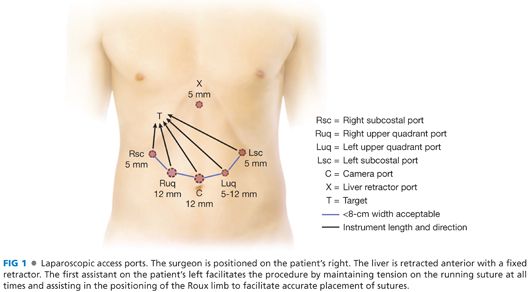Eugene P. Ceppa
DEFINITION
■ Hepaticojejunostomy is the operative formation of an anastomosis between the biliary tree and a Roux limb of the jejunum to manage biliary obstruction secondary to benign or malignant strictures, or to reconstruct continuity following resection of the extrahepatic biliary tree or pancreaticoduodenectomy.
DIFFERENTIAL DIAGNOSIS
■ Benign
■ Traumatic or iatrogenic bile duct injury
■ Chronic pancreatitis
■ Choledochal cyst
■ Mirizzi’s syndrome
■ Malignant
■ Extrahepatic cholangiocarcinoma (palliative or after resection)
■ Periampullary tumors (palliative or after resection)
■ Portal lymphadenopathy (palliative)
PATIENT HISTORY AND PHYSICAL FINDINGS
■ History—The following features may be obtained:
■ Weight loss (malignancy vs. malabsorption)
■ Fevers/chills (cholangitis)
■ Yellow eyes/skin (obstructive jaundice)
■ Tea-colored urine (obstructive jaundice)
■ Acholic stools (obstructive jaundice)
■ Right upper quadrant pain (distended gallbladder, may suggest a process distal to the cystic duct confluence)
■ Physical examination
■ Temporal wasting (cachexia)
■ Scleral icterus
■ Jaundiced skin
■ Right upper quadrant tenderness
■ Courvoisier’s sign—painless, palpable gallbladder with jaundice
IMAGING AND OTHER DIAGNOSTIC STUDIES
■ Ultrasonography—preferred initial evaluations as it is readily available and inexpensive. Findings may include the following:
■ Gallbladder
■ Stones
■ Cholecystitis
■ Biliary tree
■ Extrahepatic duct dilatation
■ Intrahepatic duct dilatation
■ Cross-sectional imaging
■ Computed tomography abdomen/pelvis (CT A/P) with intravenous (IV) contrast—Triple-phase CT A/P is warranted in most cases of obstructive jaundice as part of determining the probable etiology and defining surgical anatomy. This includes the following:
■ Determine location of hepatic arteries and potential anomalous anatomy
■ Compression, invasion, or thrombosis of portal, splenic, and/or superior mesenteric veins
■ Magnetic resonance imaging/magnetic resonance cholangiopancreatography (MRI/MRCP) with IV contrast is preferred by some institutions. It is superior to ultrasound (US) and CT in identifying the location of biliary strictures.
■ Cholangiography
■ Endoscopic retrograde cholangiopancreatography (ERCP) is the “gold standard” when biopsy or other therapeutic intent is warranted.
■ Provides superior diagnostic information by identifying level of obstruction/anatomy
■ Allows for sampling of tissues at the level of obstruction via brushings for cytology
■ Is therapeutic by placement of biliary endoprosthesis to decompress biliary tree
■ Percutaneous transhepatic cholangiography (PTC) is reserved for therapeutic intervention when ERCP is technically not feasible, that is, following gastric bypass or in the clinical setting of concomitant gastric outlet obstruction.
■ Second option—Palliation is less effective as the patient will have pain from the PTC site and will need to perform daily care to the catheter.
SURGICAL MANAGEMENT
Preoperative Planning
■ Underlying cardiopulmonary disease must be evaluated when considering the laparoscopic approach; affected patients may not tolerate reduced venous return or clear increased concentrations of carbon dioxide resultant from the pneumoperitoneum.
■ An extensive past abdominal surgical history or previous peritonitis may impact the ability to perform the hepaticojejunostomy laparoscopically due to extensive adhesions. Prior abdominal surgery may also impact the approach of initial peritoneal access and subsequent port placement (i.e., avoiding abdominal wall defects), or mandate modification of the formation or routing of the reconstructive Roux limb.
■ Morbid obesity can preclude adequate laparoscopic visualization, but these patients have the greatest potential benefit of a minimally invasive approach due to the reduced wound morbidity. Obesity mandates several considerations:
■ Distinct, longer instrumentation may be required to reach the right upper quadrant and level mechanics, thus may impact fine motor movements limitations with suturing and intracorporeal knot tying.
■ Mobilization of the hepatic flexure and a Kocher maneuver are made more difficult when the transverse mesocolon and omentum contain more fat and organs are larger in size overall.
■ Large, friable livers as a result of fatty liver disease and are prone to lacerations (hemorrhage within the operative field significantly impairs image brightness).
Positioning
■ The patient is positioned supine with both arms abducted on arm board extensions of the operating table.
■ A nasogastric tube and Foley catheter are placed.
■ Use a footboard.
TECHNIQUES
LAPAROSCOPIC CHOLEDOCHOJEJUNOSTOMY
■ Port placement and role of each in the procedure is depicted in FIG 1.

■ To first create the Roux limb, elevate and retract the omentum and transverse colon to the upper abdomen. The ligament of Treitz is identified at the base of the transverse mesocolon. Reverse Trendelenburg positioning may facilitate visualization by dropping the small bowel into the lower abdomen.
Stay updated, free articles. Join our Telegram channel

Full access? Get Clinical Tree








